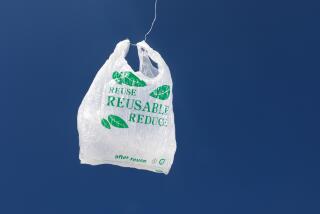Outdoor Lights Might Discourage Vandalism
- Share via
QUESTION: Will increased lighting make our home safer? The only outdoor lighting we have is a small porch light. Tall trees also block some of the street lighting.
What’s the best type of lighting for increased security? We notice that many stores now sell flood lights with sensors to turn them on and off. Are these lights a good idea? We would appreciate any information you have.
ANSWER: There is no documented evidence that proves increased lighting reduces vandalism or burglary, but most people agree that it does.
However, at certain public facilities, the occurrence of vandalism actually went down when outdoor lighting was eliminated after hours. For residences, a combination of porch lights and flood lights is usually recommended.
For porch lights, instead of a standard bulb, you could use halogen or screw-in fluorescent bulbs for higher efficiency and longer life. Compact fluorescent lamps are better than standard tubes at starting under cold conditions, but a slight reduction in light output should be expected.
By using improved color phosphors, most screw-in fluorescents also provide warm color tones similar to incandescent lights.
For flood lighting, choices include incandescent and high-intensity discharge, or HID sources. Incandescent lights, such as PAR reflector and quartz-halogen lamps, have good color, are relatively easy to install but are not very efficient. It’s best to use them with motion sensors or time clocks to ensure that they are used only when needed.
Motion sensors will turn on the lights only when they detect a person within the vicinity and have the advantage of alerting others that someone is approaching. They must be adjusted properly to avoid nuisance readings from animals, wind or other disturbances.
For areas where you want flood lighting to remain on all night, consider an HID source with photocell control. Mercury lamps have long been used for this purpose, but are now the least efficient option and produce a dull white, slightly greenish light.
A better option might be a high-pressure sodium fixture. They are very efficient; a 50-watt lamp produces as much light as a 100-watt mercury lamp or two 150-watt incandescent PAR lamps. High-pressure sodium fixtures are available in numerous designs, but generally from lighting equipment manufacturers and suppliers.
Initial installation costs are relatively high, although operating costs are very low due to reduced energy cost and long lamp life--more than 20,000 hours.
Photocells have an advantage since they don’t need to be adjusted with the changing day length or in the event of power outages. No matter what kind of flood lighting you install, be sure to aim lights away from your neighbor’s yard to avoid unnecessary glare.
Check your local hardware store for porch and floodlights.
‘Recyclable’ Plastics Not All Recyclable
Q: I noticed a recyclable plastic label on a plastic foam carry-out food container I recently purchased. Does this mean I can put it in my curbside collection for pickup? Or take it to a buy-back center?
A: No, the plastic foam container cannot go in your curbside collection bin. Only a few recyclers accept certain types of plastic (PET soft drink bottles and HDPE milk jugs) are the most common.
The recyclable label is a part of a plastics packaging industry coding system. There are seven different kinds of plastic resins used in product packaging.
According to Roger Bernstein of the Society of the Plastics Industry Inc., the basic intention of this coding system is to allow processing centers to separate the plastic by resin type. See the sidebar listing plastic types.
Unfortunately, the labeling is somewhat misleading. While most plastics are technically recyclable, they’re not practically recyclable. Currently, less than 1% of the 60 billion pounds of virgin plastic produced annually in the United States is recycled.
Disposal of plastics has grown from less than 1% of the waste stream in 1960 to 7.2% in 1986. By the year 2000 it is estimated that plastics will account for nearly 10% of the total waste system.
A recyclable material has: a technology in place that can tell what the container is made of, a collection system for the material and a market for the end product.
Experimental programs for plastics recycling have been reported by the media and the plastics industry. However, the recycling of plastics is still in a testing phase and the bulk of consumer plastics have not been easy to recycle.
Technological advances have not kept pace to a point where all plastics can be readily transformed. Presently, in this region, the only type of plastic containers that are recyclable are PET (soft drink and liquor bottles), and in some areas, milk and juice jugs, soap and detergent bottles and shampoo and lotion bottles.
PLASTIC TYPES The packaging industry has initiated a numbering system to identify the type of plastic used to manufacture the container. For example, the bottom of some yogurt containers have a 5 inside the recycling symbol.
1--PET: Polyethylene Terephthalate. Includes beverage bottles, frozen food boil-in-the bag pouches and microwave food trays.
2--HDPE: High Density Polyethylene. Includes milk jugs, trash bags, detergent, bleach and aspirin bottles.
3--V: Vinyl. Includes cooking oil bottles and packaging around meat.
4--LDPE: Low Density Polyethylene. Includes grocery store produce bags, bread bags and food wrap.
5--PP: Polypropylene. Includes yogurt containers, shampoo bottles, straws, syrup bottles and margarine tubs.
6--PS: Polystyrene: Better known as Styrofoam. Includes hot-beverage cups, fast food clamshell containers, egg cartons, and meat trays.
7--Other: All other materials (eg. nylon, acrylic).
Produced by the Washington Energy Extension Service, a division of the Washington State Energy Office. Reader questions cannot be answered individually. Questions of general interest will be addressed in this column.


